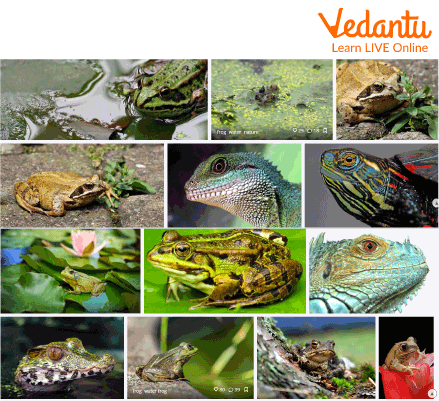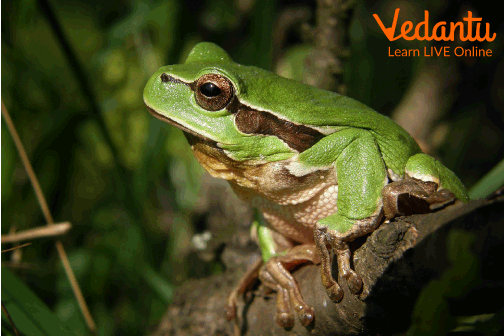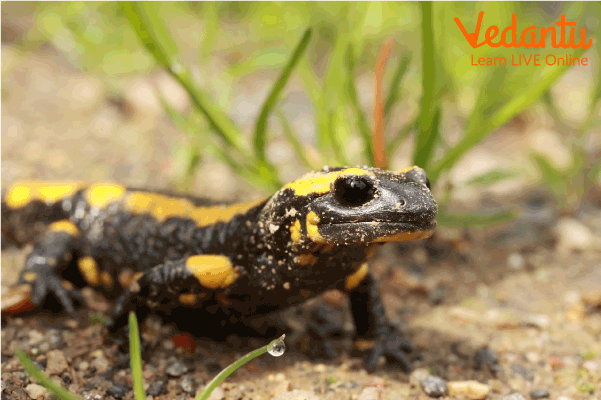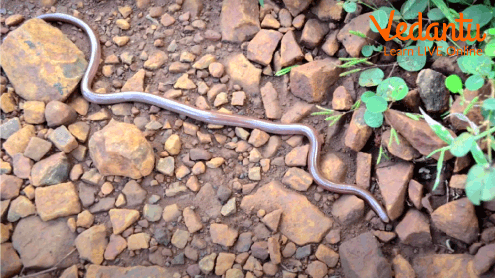




Amphibians Meaning and Examples
Amphibians Definition:Amphibians are vertebrate animals (animals with a backbone). Due to their cold blood, their body temperature is controlled by the environmental temperature. Amphibians are distinguished by their absence of scales, feathers, and hair and their smooth, slimy skin. Many amphibians breathe through their skin rather than their lungs because their skin is porous (air can pass through it).
Examples of amphibians : frogs, toads, salamanders, newts and caecilians.

Amphibians
Types of Amphibians
Here is a kid's list of the most commonly known amphibians:
Frogs
Amphibians of the order Anura include frogs. They often have no tail, webbed fingers and toes, large eyes, and a small torso. Frogs have long, strong legs and are adept jumpers. Frogs of this type of toad exist. The American bullfrog and the poison dart frog are two different species of frogs.

Frog
Salamanders
Salamanders resemble lizards in appearance. They are short-legged, have long tails, and have slender bodies. Salamanders can regrow missing body parts and limbs. They favour marshes and other moist, wet locations.

Salamander
Caecilians
Amphibians, called caecilians, lack both legs and arms. They resemble worms or snakes in appearance. Some of them can grow to lengths of more than 4 feet. They have robust cranium and a pointed nose to help them burrow through soil and mud.

Caecilians
Characteristics of Amphibians
Amphibians live in water and on land.
They are ectothermic creatures that live in warm climates.
Their head and trunk make up their entire body. There might or might not be a tail.
The skin is rough and smooth without scales, but it has glands that keep it moist.
Their fins are not paired. There may be fins that are not paired.
They have two sets of limbs for movement.
They breathe through their skin and lungs. Some adults may have gills on the outside.
They have three-chambered hearts.
Mesonephric kidneys are present. The excretory substance consists of urea and ammonia.
The sexes are distinct, and external fertilization is typical. Salamanders, on the other hand, undergo internal fertilization.
In water, breeding takes place. In males, the copulatory organs are lacking.
Metamorphosis is a form of indirect development in amphibia. It simply means that when a baby hatches from the egg, it has to go through several distinct stages of development, which are different from the adult stage, to finally reach the adult stage.
Kids List of Amphibians
Some of the examples of amphibians for kids are:
Bullfrog
American toad
Wood frog
Spotted salamander
Pacific tree frog
Facts About Amphibians
Frogs cannot survive in saltwater.
Tropical rainforests are home to more than 75% of the world's toad and frog species.
The idea that touching a frog or toad can cause warts is untrue.
Amphibians come in more than 4,000 different varieties.
Nearly all amphibians are capable of generating toxins through their skin. Some of these toxins can be detected by smell.
All amphibians have gills and tails when they first emerge from the water. For life on land, they build lungs and legs as they grow.
Frogs consume their meals whole. Their lips and stomach sizes dictate how much food they can consume.
Solved Questions
1. What do you mean by the word amphibian?
Ans: The word amphibian means any organism that can live both on land and in water.
2. Where do amphibians live?
Ans: Amphibians can survive both on land and water.
3. How many chambers does an amphibian heart have?
Ans: Amphibians have a three-chambered heart.
Learning by Doing
Write true or false for the following.
Amphibians are warm-blooded vertebrates________
Amphibians have a three-chambered heart______
Amphibians can only survive in terrestrial habitat______
Summary
Amphibians' definition is that they are cold-blooded vertebrates with smooth and slimy skin. They make their presence in both aquatic and terrestrial adaptations as such the word amphibian means two lives. Streams, woodlands, meadows, bogs, swamps, ponds, rainforests, and lakes are just a few of the numerous habitats in which amphibians have evolved to survive. The majority of them like to reside in wet, water-related environments. Examples of amphibians for kids are bullfrog, toad, newt etc
Adult amphibians hunt and consume prey. They consume a range of foods, such as worms, spiders, and beetles. To catch their prey, some of them, like frogs, fling out their lengthy tongues with sticky endings.
FAQs on Amphibians
1. What defines an animal as an amphibian?
An amphibian is a type of cold-blooded vertebrate animal that is distinguished by its ability to live both in water and on land. The name itself means "two lives," which points to their life cycle that typically starts in water as larvae and continues on land as adults. A key characteristic is their moist, permeable skin, which often helps them breathe.
2. Can you give some common examples of amphibians?
Yes, some of the most well-known examples of amphibians that students learn about include:
Frogs: Known for their strong legs used for jumping.
Toads: Often have drier, bumpier skin compared to frogs.
Salamanders: Resemble lizards but have smooth, moist skin and no scales.
Newts: A type of small salamander, often found in water.
Caecilians: Legless amphibians that look like large worms or snakes.
3. What is the main difference between an amphibian and a reptile?
The primary difference is in their skin and eggs. Amphibians have moist, smooth skin that can absorb water and oxygen, and they lay soft, gel-like eggs in water. In contrast, reptiles (like lizards and turtles) have dry, scaly skin that prevents water loss, and they lay hard-shelled eggs on land.
4. How do amphibians breathe in both water and on land?
Amphibians have a fascinating dual breathing system. As young larvae, like tadpoles, they live in water and breathe using gills. As they mature into adults, they develop lungs to breathe air on land. Additionally, many adult amphibians can absorb oxygen directly through their moist skin, a process known as cutaneous respiration.
5. What do most amphibians eat?
Most adult amphibians are carnivores, preying on a variety of small creatures. Their diet typically includes insects, spiders, worms, and slugs. The diet of their young (larvae) is often different; for example, tadpoles are usually herbivores that feed on algae and decaying plant matter in the water.
6. Why do amphibians need to live near water?
Amphibians must live in or near water for two critical reasons. First, their skin is not waterproof and they need to keep it moist to survive and breathe properly. If their skin dries out, they can die. Second, most amphibians need to return to the water to lay their eggs, as the eggs lack a protective shell and would dry out on land.
7. What is metamorphosis in amphibians?
Metamorphosis is the remarkable process of transformation that amphibians undergo from their larval stage to their adult form. A classic example is a frog's life cycle: it starts as an egg in water, hatches into a fully aquatic tadpole with gills and a tail, and then gradually grows legs, loses its tail, and develops lungs to become an adult frog capable of living on land.
8. Why do amphibians have moist or slimy skin?
The moist and often slimy skin of an amphibian is a vital feature. This moisture is essential for cutaneous respiration (breathing through the skin), which supplements their lung-based breathing. The slime also offers protection from predators, helps them move easily, and prevents their skin from drying out completely when on land.
9. What are the three main groups of amphibians?
Amphibians are scientifically classified into three main orders:
Anura: This group includes frogs and toads, which are characterised by their lack of a tail in adulthood.
Urodela (or Caudata): This group contains salamanders and newts, which are amphibians that retain their tails throughout their lives.
Apoda (or Gymnophiona): This is the order of caecilians, which are amphibians that are legless and have a worm-like appearance.
10. Do all amphibians lay eggs?
While the vast majority of amphibians, like frogs and salamanders, are oviparous (egg-laying), there are some interesting exceptions. A small number of amphibian species are viviparous, meaning they give birth to live young instead of laying eggs. This adaptation is more common in certain species of caecilians and a few salamanders.









